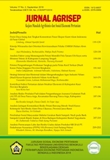Main Article Content
Abstract
The low production of cassava forcesIndonesia to import from other countries. The
efforts to increase production and productivity are necessary in order to fulfill domestic needs. Cassava cultivation technology is expected to assist in increasing production. This study aims to analyze the factors that affect cassava farmers to choose cropping patterns and estimate technical efficiency in Lampung. Analytical methods used are binary logitto in 91 respondents with simple random sampling determine the factors that influence planting pattern and Data Envelopment analysis (DEA) to measure farmer efficiency level. Primary data used through questionnaire interview, and secondary data obtained from institution. The results showed that there are 4 significant variables that affect farmers' cropping pattern that is the area of land, the distance of land to the factory, the income while the education level hasno significant effect. Intercroppingfarmers are more efficiently than monoculture farmers with percentages of 77.41 and 45.
Article Details
Authors who publish with this journal agree with the following terms:
- Authors retain copyright and grant the journal right of first publication with the work simultaneously licensed under a Creative Commons Attribution-ShareAlike 4.0 International License that allows others to share the work with an acknowledgment of the work's authorship and initial publication in this journal.
- Authors are able to enter into separate, additional contractual arrangements for the non-exclusive distribution of the journal's published version of the work (e.g., post it to an institutional repository or publish it in a book), with an acknowledgment of its initial publication in this journal.
- Authors are permitted and encouraged to post their work online (e.g., in institutional repositories or on their website) prior to and during the submission process, as it can lead to productive exchanges, as well as earlier and greater citation of published work (See The Effect of Open Access).
- This work is licensed under a Creative Commons Attribution-ShareAlike 4.0 International License.
References
- [BPS] Badan Pusat Statistik. 2015. Perkembangan Harga Ubi kayu di Indonesia 2002-2015. Jakarta[ID]: Badan Pusat Statistik.
- [BPS] Badan Pusat Statistik. 2016. Statistik data Lahan, produksi dan produktivitas [publikasi] Jakarta (ID): BPS.
- Cooper DR, Emory CW.1996.Metode Penelitian Bisnis. Jilid 1. Jakarta:Erlangga
- Cooper WW, Seiford LM, Zhu J. 2002. Data Envelopment Analysis: History, Models, and Interpretations. Journal of Econometrics. 46
- Frances, CA. and Floor, C.A.1975. Adapting Varieties for intercropping ayatems in the Tropics”, Paper presented n Symposium American Society
- Agronomy Knoxville, Tennessee, USA.
- Hosmer DW, Lemeshow S.2000. Applied Logistic Regression . New Jersey (US): John Wiley & Sns, Inc.
- [Kementan] Kementrian Pertanian. 2012. Pedoman teknis pengelolaan produksi ubikayu Tahun 2012. Direktorat Budidaya Aneka Kacang Dan Umbi. Jakarta (ID) : Direktorat Jendral Tanaman Pangan.
- Kusnadi N, Netti T, Sri HS, Adreng P. 2011. Rice Farming Efficiency Analysis in Some Rice Producing Areas in Indonesia. Jurnal Agro Ekonomi. 29(1):25-48
- [Pusdatin] Pusat Data dan Informasi. 2016. Outlook ubi kayu 2016. Jakarta [ID]: Kementrian Pertanian.
- Samosir, S.S.R. 1996 Pengolahan lahan kering. Makalah yang disampaikan pada seminar nasional II Budidaya Lahan Kering. Dalam rangka Dies Natalis XV Unhalu, Kendari.
References
[BPS] Badan Pusat Statistik. 2015. Perkembangan Harga Ubi kayu di Indonesia 2002-2015. Jakarta[ID]: Badan Pusat Statistik.
[BPS] Badan Pusat Statistik. 2016. Statistik data Lahan, produksi dan produktivitas [publikasi] Jakarta (ID): BPS.
Cooper DR, Emory CW.1996.Metode Penelitian Bisnis. Jilid 1. Jakarta:Erlangga
Cooper WW, Seiford LM, Zhu J. 2002. Data Envelopment Analysis: History, Models, and Interpretations. Journal of Econometrics. 46
Frances, CA. and Floor, C.A.1975. Adapting Varieties for intercropping ayatems in the Tropics”, Paper presented n Symposium American Society
Agronomy Knoxville, Tennessee, USA.
Hosmer DW, Lemeshow S.2000. Applied Logistic Regression . New Jersey (US): John Wiley & Sns, Inc.
[Kementan] Kementrian Pertanian. 2012. Pedoman teknis pengelolaan produksi ubikayu Tahun 2012. Direktorat Budidaya Aneka Kacang Dan Umbi. Jakarta (ID) : Direktorat Jendral Tanaman Pangan.
Kusnadi N, Netti T, Sri HS, Adreng P. 2011. Rice Farming Efficiency Analysis in Some Rice Producing Areas in Indonesia. Jurnal Agro Ekonomi. 29(1):25-48
[Pusdatin] Pusat Data dan Informasi. 2016. Outlook ubi kayu 2016. Jakarta [ID]: Kementrian Pertanian.
Samosir, S.S.R. 1996 Pengolahan lahan kering. Makalah yang disampaikan pada seminar nasional II Budidaya Lahan Kering. Dalam rangka Dies Natalis XV Unhalu, Kendari.
